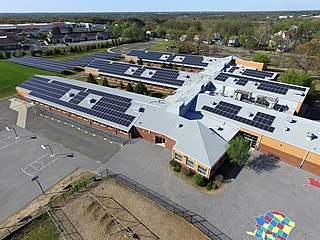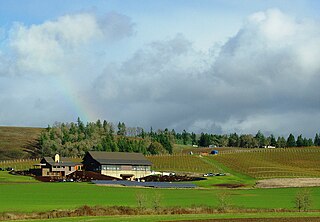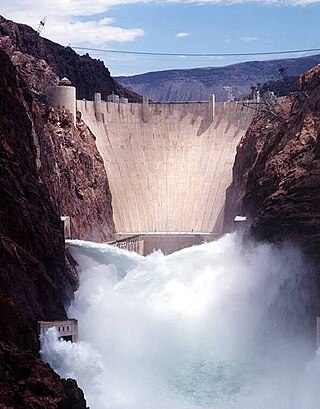Energy in Oregon
The largest source of renewable energy in Oregon is hydropower. [2] The majority of Oregon's energy consumption comes from the transportation sector, followed by industrial use, residential use, and commercial use. [2]

The Oregon Department of Energy (ODOE) was established in 1975 by the Oregon Legislative Assembly as the culmination of recommendations of several task forces and study groups over several years. The state agency helps Oregonians make informed decisions and maintain a resilient and affordable energy system. ODOE advances solutions to shape an equitable clean energy transition, protect the environment and public health, and responsibly balance energy needs and impacts for current and future generations. ODOE's vision is: "A safe, equitable, clean, and sustainable future." ." [1]
The largest source of renewable energy in Oregon is hydropower. [2] The majority of Oregon's energy consumption comes from the transportation sector, followed by industrial use, residential use, and commercial use. [2]

In accordance with the Renewable Portfolio Standard (RPS), renewable energy sources in Oregon are growing. The RPS was created in 2007, but was updated in 2016 to require that 50% of energy consumption in Oregon must come from renewable energy by 2040. [3] ODOE is responsible for tracking the progress towards this goal in addition to helping institute ways to reach it through various programs. Suppliers that provide renewable energy sources contributing to RPS are awarded renewable energy certificates (REC). [4] A REC is received by a supplier for one MegaWatt hour worth of renewable energy. [4] The complete rules for establishing eligibility for a REC are listed in The Oregon Administrative Rules. These companies must submit annual compliance forms in order to continue to receive RECs.
Between 2012 and 2019, ODOE awarded over $9 million for 92 renewable energy projects statewide, including solar, hydropower, biogas, biomass, and geothermal installations. The RED Grant program promoted investment in and development of renewable energy projects by providing a grant up to $250,000 for businesses, organizations, public bodies, schools, nonprofits, and tribes that install and operate a renewable energy system that produces electric energy.
Renewable Energy Certificates (RECs), also known as Green tags, Renewable Energy Credits, Renewable Electricity Certificates, or Tradable Renewable Certificates (TRCs), are tradable, non-tangible energy certificates in the United States that represent proof that 1 megawatt-hour (MWh) of electricity was generated from an eligible renewable energy resource and was fed into the shared system of power lines which transport energy. Solar renewable energy certificates (SRECs) are RECs that are specifically generated by solar energy.

The energy policy of the United States is determined by federal, state, and local entities. It addresses issues of energy production, distribution, consumption, and modes of use, such as building codes, mileage standards, and commuting policies. Energy policy may be addressed via legislation, regulation, court decisions, public participation, and other techniques.
A Renewable Portfolio Standard (RPS) is a regulation that requires the increased production of energy from renewable energy sources, such as wind, solar, biomass, and geothermal, which have been adopted in 38 of 50 U.S. states and the District of Columbia. The United States federal RPS is called the Renewable Electricity Standard (RES). Several states have clean energy standards, which also allow for resources that do not produce emissions, such as large hydropower and nuclear power.
The New York State Energy Research and Development Authority (NYSERDA), established in 1975, is a New York State public-benefit corporation, located in Albany, New York, with regional offices in New York City, Buffalo, and West Valley.

Wind power in Texas, a portion of total energy in Texas, consists of over 150 wind farms, which together have a total nameplate capacity of over 30,000 MW. If Texas were a country, it would rank fifth in the world: The installed wind capacity in Texas exceeds installed wind capacity in all countries but China, the United States, Germany and India. Texas produces the most wind power of any U.S. state. According to the Electric Reliability Council of Texas (ERCOT), wind power accounted for at least 15.7% of the electricity generated in Texas during 2017, as wind was 17.4% of electricity generated in ERCOT, which manages 90% of Texas's power. ERCOT set a new wind output record of nearly 19.7 GW at 7:19 pm Central Standard Time on Monday, January 21, 2019.

The United States produced 5.2 billion metric tons of carbon dioxide equivalent greenhouse gas (GHG) emissions in 2020, the second largest in the world after greenhouse gas emissions by China and among the countries with the highest greenhouse gas emissions per person. In 2019 China is estimated to have emitted 27% of world GHG, followed by the United States with 11%, then India with 6.6%. In total the United States has emitted a quarter of world GHG, more than any other country. Annual emissions are over 15 tons per person and, amongst the top eight emitters, is the highest country by greenhouse gas emissions per person. However, the IEA estimates that the richest decile in the US emits over 55 tonnes of CO2 per capita each year. Because coal-fired power stations are gradually shutting down, in the 2010s emissions from electricity generation fell to second place behind transportation which is now the largest single source. In 2020, 27% of the GHG emissions of the United States were from transportation, 25% from electricity, 24% from industry, 13% from commercial and residential buildings and 11% from agriculture. In 2021, the electric power sector was the second largest source of U.S. greenhouse gas emissions, accounting for 25% of the U.S. total. These greenhouse gas emissions are contributing to climate change in the United States, as well as worldwide.
Renewable energy law is a particular kind of energy law, and relates primarily to the transactional legal and policy issues that surround the development, implementation, and commercialization of renewable sources of energy, such as solar, wind, geothermal and tidal. Renewable energy, (RE) law also relates to the land use, siting, and finance issues encountered by developers of renewable energy projects.
A Renewable energy credit (REC) is a certificate corresponding to the environmental attributes of energy produced from renewable sources such as wind or solar. RECs were created as a means to track progress towards and compliance with states' Renewable Portfolio Standards (RPS), meant to support a cleaner generation mix.
New York has 2,192 MW of installed wind power capacity as of 2022. Most of New York's wind power is located in upstate New York as onshore wind farms. New York has set a goal of developing 9,000 MW of offshore installed wind power capacity by 2035 that will power an estimated 6 million homes. As of October 2022, New York has five offshore wind farms in development with approximately 4,300 MW installed capacity.

New Jersey has over 4,100 MW of install solar power capacity as of mid-2022, which provides 6.7% of the state's electricity consumption. The's state's growth of solar power is aided by a renewable portfolio standard that requires that 22.5% of New Jersey's electricity come from renewable resources by 2021 and 50% by 2030, by incentives provided for generation of solar power, and by one of the most favorable net metering standards in the country, allowing customers of any size array to use net metering, although generation may not exceed annual demand. As of 2018, New Jersey has the sixth-largest installed solar capacity of all U.S. states and the largest installed solar capacity of the Northeastern States.
Solar Renewable Energy Certificates (SRECs) or Solar Renewable Energy Credits are a form of Renewable Energy Certificate or "Green tag" existing in the United States of America. SRECs exist in states that have Renewable Portfolio Standard (RPS) legislation with specific requirements for solar energy, usually referred to as a "solar carve-out". The additional income received from selling SRECs increases the economic value of a solar investment and assists with the financing of solar technology. In conjunction with state and federal incentives, solar system owners can recover their investment in solar by selling their SRECs through spot market sales or long-term sales, both described below.
There is a large array of stakeholders that provide services through electricity generation, transmission, distribution and marketing for industrial, commercial, public and residential customers in the United States. It also includes many public institutions that regulate the sector. In 1996, there were 3,195 electric utilities in the United States, of which fewer than 1,000 were engaged in power generation. This leaves a large number of mostly smaller utilities engaged only in power distribution. There were also 65 power marketers. Of all utilities, 2,020 were publicly owned, 932 were rural electric cooperatives, and 243 were investor-owned utilities. The electricity transmission network is controlled by Independent System Operators or Regional Transmission Organizations, which are not-for-profit organizations that are obliged to provide indiscriminate access to various suppliers to promote competition.

Solar power has been growing in the U.S. state of Oregon in recent years due to new technological improvements and a variety of regulatory actions and financial incentives enacted by the state government.
CleanPowerSF is the City and County of San Francisco's Community Choice Aggregation (CCA) program, whose purpose is to significantly increase the proportion of electrical energy supplied to the San Francisco electrical grid from local renewable sources, decrease San Francisco's greenhouse gas (GHG) emissions, and help combat global climate change, while meeting or exceeding California's Renewable Portfolio Standard (RPS). The RPS requires that 33% of energy supplied by "investor-owned utilities, electric service providers, and community choice aggregators" should be from eligible renewable sources by 2020.
Modern United States wind energy policy coincided with the beginning of modern wind industry of the United States, which began in the early 1980s with the arrival of utility-scale wind turbines in California at the Altamont Pass wind farm. Since then, the industry has had to endure the financial uncertainties caused by a highly fluctuating tax incentive program. Because these early wind projects were fueled by investment tax credits based on installation rather than performance, they were plagued with issues of low productivity and equipment reliability. Those investment tax credits expired in 1986, which forced investors to focus on improving the reliability and efficiency of their turbines. The 1990s saw rise to a new type of tax credit, the production tax credit, which propelled technological improvements to the wind turbine even further by encouraging investors to focus on electricity output rather than installation.

Hydropower policy in the United States includes all the laws, rules, regulations, programs and agencies that govern the national hydroelectric industry. Federal policy concerning waterpower developed over considerable time before the advent of electricity, and at times, has changed considerably, as water uses, available scientific technologies and considerations developed to the present day; over this period the priority of different, pre-existing and competing uses for water, flowing water and its energy, as well as for the water itself and competing available sources of energy have changed. Increased population and commercial demands spurred this developmental growth and many of the changes since, and these affect the technology's use today.

Solar power in Connecticut establishes Connecticut as the second state in the US to reach grid parity, after Hawaii, due to the high average cost of electricity. Installing solar panels for a home provides an estimated 15.6% return on investment.

Solar power in Maryland is supported by the state's legislation regarding the Renewable Portfolio Standard and Solar Renewable Energy Credit (SREC) program. The target for renewable energy as of 2017 is 20% by 2020, including 2% from solar power.

Solar power in Pennsylvania currently provides less than 1% of the state's electricity, but there are many policies in place to regulate and incentivize its use. Pennsylvania mandates the use of solar power through a renewable portfolio standard, which requires a percentage of electricity from each providers to come from solar, and net metering, which compensates small-scale solar generation through net metering. By 2021, Pennsylvania was required to have 0.5% of its electricity from solar. Their following goal is 10% by 2030. Solar power could theoretically provide over 30% of the state's electricity, but growth in solar generation has slowed due to a reduction in solar grants and the low price of solar energy credits. Efforts have also seen blowback from citizens, most notably from Mount Joy Township. Although, Pennsylvania has ruled solar as a legal use, meaning local governments can only restrict size and placement, but can't disband the projects.
A renewable portfolio standard (RPS) is a regulation that requires the increased production of energy from renewable energy sources, such as wind, solar, biomass, and geothermal. Other common names for the same concept include Renewable Electricity Standard (RES) at the United States federal level and Renewables Obligation in the UK.